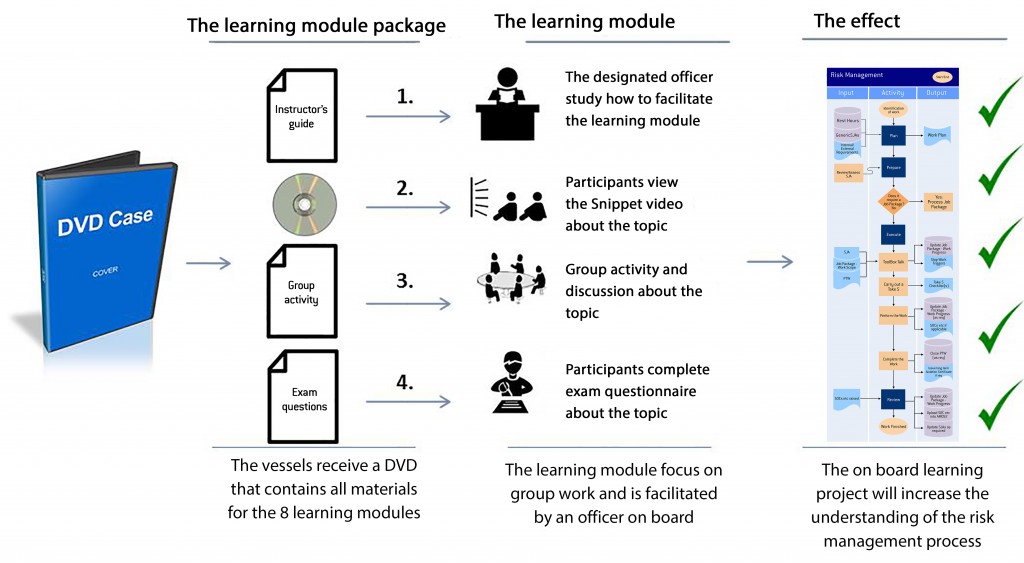Interview with Søren Eliassen, H&S Manager/Deputy DPA/CSO in Maersk Supply Service A/S
Please describe the background: Why have you launched an on board training concept in your fleet?
Our former training had become outdated due to implementation of new systems and an update of our Risk Management process. Several of our processes had been changed, for example the Risk Assessment process, and we lacked training in Permit to Work – a subject that has to meet certain requirements from our clients. So all in all, our training system was old and insufficient.
Previously, we were running safety courses for ratings, these were one-day courses kept at a reasonable cost. To assess the outcome of these courses I participated in some of them and it was my impression that the value for and engagement from the seafarers was rather limited. Therefore we wanted to go new ways and find an alternative way of training the seafarers with the goal to engage them more. Therefore it was optimal to let the training take place in the environment where they work. Besides there is an economic advantage as resources are better utilised.
You decided to develop an on board training product – what does it contain and how does it bring learning on board in practice?
We have developed eight on board training modules covering our entire risk management process. The process is more or less the same, but the training covers more because we have included the Stop Work Authority and Take 5, which are the safety mindset and principles we apply in Maersk Supply Service. Now, as we were renewing our training, was a good opportunity to include essential safety issues. We wanted to provide something different from traditional computer based training. People on board are much better at having a dialogue about safety, and through this concept they participate much more actively. The Green-Jakobsen on board learning modules makes it easier to relate to real life conditions and the learning is therefore much easier to remember.
All modules must be taken every second year as they contain competencies that are to be maintained constantly, hence the certificate you receive must be currently renewed.
How have you launched it, and how has it been received?
First of all we had to consider how it should be distributed – should it be on a USB or a DVD. It was too much data to make it a data transfer on to the vessels, therefore we chose the DVD solution. The concept was launched through articles on our intranet and in quarterly mails sent to the vessels. We also made some safety posters about it. We are currently following up to know if the DVDs have been received and applied on board. We have had to remind a few vessels in order to start the training process. The concept is giving guidance to the person who shall do the instruction on board, preferably the safety officer or a senior officer. This guidance explains how a learning session can be held on board, for example at the weekly safety meeting. To go through a module takes about one hour – I have tried them myself and it is a suitable time frame which can be set aside on board without problems.
I have not had any kind of negative reaction to this. A few were not getting the idea behind the concept from the beginning as they only viewed the video (it is also necessary to do the exercises and a multiple choice exam). The advantage is that the theoretical part is short and easily comprehensible – it may even seem a bit trivial at times – but it creates a good discussion in which everyone can participate and it is therefore a good, pragmatic solution. We have even run the modules together with clients with whom we work very closely.
The conclusion is that it has totally replaced the conventional courses and it is a much better investment for us as the training costs are smaller and the participation and outcome much higher. It is a concept that has come to stay as we see it as a lasting solution.
All modules have been texted in Portuguese as we have a large pool of Portuguese speaking seafarers. In Brazil we have been able to present the learning to the seafarers during a pre-embarkation meeting; however, some vessels also do it on board themselves.
The on board training modules were developed in cooperation between Green-Jakobsen and Maersk Supply Service. One person from each company has been the focal points for this work throughout the development. A few times time constraints from either party have been a challenge, but despite the geographical distance (UK and Philippines – and to some extent also Denmark) the work has proceeded to the satisfaction of both parties. We have definitely got the product we wanted and it seems that our seafarers are now more actively engaged in the training.

Contact us for personal advice
Would you like us to call you?


